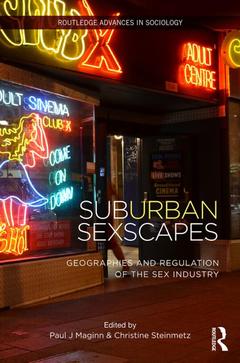Description
(Sub)Urban Sexscapes
Geographies and Regulation of the Sex Industry
Routledge Advances in Sociology Series
Coordinators: Maginn Paul, Steinmetz Christine
Language: English
Subject for (Sub)Urban Sexscapes:
Keywords
(Sub)Urban Sexscapes; Geographies and Regulation of the Sex Industry; Paul J; Maginn; Christine Steinmetz; commercial sex; spatial sexualisation; pornification; sex consumption; sexuality; prostitution; pornography; sex industry; sexualised city; desire; promiscuity; deviance; eroticism; entertainment; seduction; BDSM; Juliet Richters; Amber Martin; sex shop; high street; strip club; Moriah McSharry McGrath; John Scott; telecommunications; Victor Minichello; Andrew Gorman-Murray; Jason Prior; Phil Hubbard; taboo risk; community space; heterosexual; homosexual; queer; Eric Kelly; Connie Cooper; Richard McCleary; adult entertainment; Alan C; Weinstein; Jean-Francois Staszak; Penny Crofts; legal prostitution; Barb Brents; Petra Doan; Catherine MacPhail; Victor Minichiello; Billie Lister; Sex Industry Premises; Alan McKee; Urban Sexscapes; Brian McNair; Coco De Mer; Anne-Frances Watson; Erotic Boutiques; Jean-François Staszak; Commercial Sex Premises; Petra L; Doan; Lap Dance Clubs; NSW Government; Barbara G; Brents; Eric Damian Kelly; Connie B; Cooper; Child Sexual Abuse Materials; Paul J Maginn; Sex Entertainment Venues; Street Based Sex Work; Negative Secondary Effects; Strip Clubs; Sex Shops; Adult Retail; Sex Premises; Commercial Sex Industry; LGBT Community; Sydney LGA; MSW; Sex Businesses; BDSM Practices; Internet Escorts
Publication date: 10-2014
Support: Print on demand
Publication date: 04-2017
· 15.6x23.4 cm · Paperback
Description
/li>Contents
/li>Readership
/li>Biography
/li>
(Sub)Urban Sexscapes brings together a collection of theoretically-informed and empirically rich case studies from internationally renowned and emerging scholars highlighting the contemporary and historical geographies and regulation of the commercial sex industry. Contributions in this edited volume examine the spatial and regulatory contours of the sex industry from a range of disciplinary perspectives?urban planning, urban geography, urban sociology, and, cultural and media studies?and geographical contexts?Australia, the UK, US and North Africa.
In overall terms, (Sub)urban Sexscapes highlights the mainstreaming of commercial sex premises?sex shops, brothels, strip clubs and queer spaces?and products?sex toys, erotic literature and pornography?now being commonplace in night time economy spaces, the high street, suburban shopping centres and the home. In addition, the aesthetics of commercial and alternative sexual practices?BDSM and pornography?permeate the (sub)urban landscape via billboards, newspapers and magazines, television, music videos and the Internet.
The role of sex, sexuality and commercialized sex, in contributing to the general character of our cities cannot be ignored. In short, there is a need for policy-makers to be realistic about the historical, contemporary and future presence of the sex industry. Ultimately, the regulation of the sex industry should be informed by evidence as opposed to moral panics.
*** Winner of the Planning Institute of Australia (WA) 2015 Award for Excellence in Cutting Edge Research and Teaching ***
Introduction 1. Spatial and Regulatory Contours of the (Sub)Urban SexscapePart I: Geographies of the Sex Industry 2. Cosmo-Sexual Sydney: Global city status, urban cosmopolitanism and the (sub)urban sexscape3. Sex Shops in England’s Cities: From the backstreets to the high streets. 4. Conflict and Coexistence? Strip Clubs and Neighbors in ‘Pornland’, Oregon 5. Telecommunications Impacts on the Structure and Organisation of the Male Sex Industry6. Housing Sex within the City: The placement of sex services beyond respectable domesticity?7. The Landscape of BDSM Venues: A view from down under Part II: Regulation of the Sex Industry 8. Sexual Entertainment, Dread Risks and the Heterosexualization of Community Space 9. Sex and the Virtual Suburbs: The pornosphere and community standards. 10. Planning prostitution in colonial Morocco: Bousbir, Casablanca’s Quartier reserve11. Regulating Adult Business to Make Spaces Safe for Heterosexual Families in Atlanta 12. Legal Landscapes of Erotic Cities: Comparing legal ‘prostitution’ in New South Wales and Nevada13. From Perception to Reality: Negative secondary effects and effective regulation of sex businesses in the US Conclusions 14. Conclusion: Towards pragmatic regulation of the sex industry
Paul J. Maginn is Associate Professor of Urban and Regional Planning at The University of Western Australia. He is co-editor of three previous books: Planning Australia: An Overview of Urban and Regional Planning (with Susan Thompson); Qualitative Urban Analysis: An International Perspective; and Qualitative Housing Analysis: An International Perspective (both with Susan Thompson & Matthew Tonts). He has recently completed research on male sex workers/escorts in Ireland (with Graham Ellison, QUB) and undertaking research on the regulation of sex work in Scotland. In addition to his research on the sex industry, Paul is conducting research on strategic planning and planning reform in Australia.
Christine Steinmetz is a Senior Lecturer in the Bachelor of Planning program at the University of New South Wales, Australia. Her research on contentious land-uses in the urban environment, particularly the adult entertainment and commercial sex industries in Sydney, focuses on planning and regulation around these land uses, progressive and best models 'in practice' from a global perspective, and the significant contribution commercial sex brings to the night time economy. Numerous publications reflect her main areas of interest: subcultural sex-on-premises venues and the regulatory framework that surrounds them; generational cohorts and their perceptions of the meaning of place on university campuses; and, postgraduate student experiences undertaking higher research degrees.

